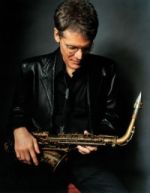 To hear popular jazz musician David Sanborn tell the story, his music, and his life, have been shaped by a string of limitations.
To hear popular jazz musician David Sanborn tell the story, his music, and his life, have been shaped by a string of limitations.Because of a childhood bout with polio, Sanborn's lungs have limited capacity — hardly ideal for a horn player, he says. His left arm is weaker and smaller than his right, limiting his range of movement. Dexterity in his left hand is also impaired, forcing further compromises with his art.
Sanborn's ailments don't stop there. His right leg, which was paralyzed when he was a child, is still weaker than his left. It's also shorter. As a result, he fatigues easily.
Even his choice of instrument, the alto sax, was influenced by his bout with polio. The alto is smaller than its cousins, such as the tenor and baritone, so it's easier to hold during long performances.
Sanborn is known for a cool but gritty sound, a sound that has wowed his fans for more than 30 years. His unique style — his ability to take standards and make them his own is one hallmark; distinctive musical arrangements are another — has earned him a global following and seven Grammys.
No one seems more surprised by the way things have turned out for him than Sanborn himself. "So much of my life has been accidental," he says.
He doesn't try to hide the fact that he had polio. But he also doesn't talk about it very often, either. Like most musicians, he would much rather talk about his art. Or other musicians. Or even politics. But his medical history? Please.
"I don't think of myself as a victim," he says. "This is my reality."
And Sanborn's reality continues to be shaped by the aftershocks of one of the world's most famous and dreaded diseases.
Nasty reminder
Polio epidemics broke out in Europe and spread to the USA in the early 1900s. The introduction of the Salk vaccine in 1955 helped eradicate the disease in the USA and in most parts of the world. But before then, the disease had crippled or deformed more than 20 million people worldwide, about 1.6 million of those in the USA.
It left behind a nasty reminder in the form of PPS, short for Post Polio Syndrome. The chronic condition mimics polio, making it an insidious — and constant — reminder of the vanquished disease.
PPS has a laundry list of symptoms. Extreme fatigue, muscle impairment and memory problems are common, says Julie Silver, an assistant professor at Harvard. About 60% of polio victims will eventually develop PPS, she says.
As many as 400,000 people in the USA are believed to have PPS now, Silver says. An exact number is difficult to pin down because of the elusive nature of the condition.
PPS symptoms tend to start showing up a decade or more after the actual polio attack. Because PPS has so many symptoms, sufferers might think they're simply tired, or just getting the flu. "It's easy to misdiagnose," Silver says.
There is no medical test for PPS. Doctors have to go through a process of elimination to diagnose the condition, which tends to worsen over time. Also, many doctors aren't familiar with PPS. "People are often told they're hypochondriacs," Silver says.
Theories abound about why PPS occurs. Lauro Halstead, director of the Post-Polio Program at the National Rehabilitation Hospital in Washington, D.C., says muscle fatigue is a main culprit.
"If you're born with 1,000 muscles and lose some of those (to polio), then you're working the others more," says Halstead, a polio survivor. "PPS is caused by overuse of those remaining muscles."
Slowing down
Sanborn's bout with polio was particularly ugly: The virus attacked his left arm, right leg and lungs when he was just 3. Unable to breathe on his own, Sanborn spent a year in an iron lung.
To help strengthen his respiratory system, a doctor suggested that young David take up a wind instrument. Sanborn, just 11 at the time, chose the saxophone.
Born in Tampa, Sanborn spent most of his youth trying to find his musical style. His family's move to St. Louis, with its long roots in gospel, blues and jazz, was the inspiration he needed. The rest, as they say, is history.
For those watching Sanborn perform, "polio victim" doesn't exactly jump to mind. As he put his band through the paces at the Blue Note club in New York recently, Sanborn delivered impressively.
And he has a new album, Closer, due for release in January. But after decades of non-stop action, Sanborn is finally slowing down. Part of that is age — he recently turned 60. Part of that is PPS.
To help curb his fatigue, Sanborn has cut back on his touring schedule. He's also does daily breathing exercises. And he doesn't lift things. Sudden movements — even a hug — can knock his ribs out of alignment, causing problems for his delicate lungs and diaphragm.
Sanborn isn't complaining, however. "I'm pragmatic," he says. "This is the functional reality of my life."
More than anything, Sanborn says he is grateful — for his music, his health and his continuing journey in life.
"I'm just happy to do what I do," he says. "And I'm happy that people still show up. I hope it will continue for a while."
By Leslie Cauley, USA TODAY
Technorati tag: Jazz
No comments:
Post a Comment